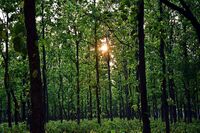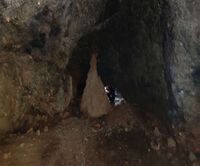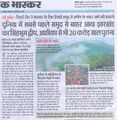Saranda Forest

Saranda forest (सारंडा वन) is a dense forest in the hilly region of West Singhbhum, East Singhbhum, Saraikela Kharsawan districts in the Indian state of Jharkhand. This area used to be the private hunting reserve of the Singh Deo family (the erstwhile royal family of Saraikela). The forest covers an area of 820 km².[1] Saranda (Serengda) literally means water is from rock[2] Author visited the area on 18.1.1981.
Origin
Saranda Forest derives its name from word 'Saranda' which means Elephant in local language 'Ho' due to abundance of Elephants in this area. Saranda literally means area of 700 hills.
Variants
- Saranda forest (सारण्डा वन)
- Saranda River (सारण्डा नदी)
People
Ho people inhabit the area, which is dotted with iron ore mining towns including Gua, Chiria, Kiriburu and Noamundi'
Flora and Fauna
Sal (Shorea robusta) is the most important tree in the area and it seems to have a preference for the rocky soil of the area. Although sal is a deciduous tree and sheds its leaves in early summer, the forest undergrowth is generally evergreen, which has such trees as mangoes, jamun, jackfruit, and piar. Other important trees are mahua, kusum, tilai, harin hara (Armossa rohitulea), gular (Ficus glomerata), and asan.[3]
The reserved forests are the haunt of many animals. Wild elephants are common in Saranada and Porahat forests. It is an important overlapping habitat of the elephants from adjacent Kedunjhar (Keonjhar) district of Orissa. Herds of sambar and chital roam about the forests. Bison is still found. Tigers were never numerous but they are there. Leopards are more common.[4]
1100 hectares of virgin forests of >40% canopy cover is under iron ore mining leases. Several new aspirants for mining lease are in the waiting. The perennial rivers, Karo and Koina, pass through these forested areas supporting a diverse floral and faunal resource. However 70-80% of the forests were destroyed, trees harvested. The site is facing an ecological crisis.
Forest Types
1. Northern Dry Mixed Deciduous Forest (5B/C2)
2. Dry Peninsular Sal Forest (5B/C1c): Main species - Anogeissus latifolia, Boswelia serrata (धावड़ा), Gardenea sp., Eulaliopsis binata etc.
3. Moist Peninsular Sal Forest (3C/C2E)
4. Northern Tropical Wet Evergreen Forest (1B) or Semi-Evergreen (2B)
- Common species are Litsea litida, lea robusta, Michelia champaka
Maoist and Naxal influences
The area was previously disturbed by Maoist and Naxal influences, but problems have subsided in recent years, and it has turned out to be a major tourist hub. There are many tourist places in the Manoharpur region. The peak season between October and March is now brimming with tourists.[5]
Thalkobad
Thalkobad is a scenic village at a height of 550 m (1,800 ft) in the heart of the forest.[6] Thalkobad is about 89 km from Chakradharpur, 46 km from Manoharpur, and about 160 kmfrom Jamshedpur.
सारंडा वन
सारंडा वन: सारंडा वन एशिया का सबसे घना साल वन और विराट जंगल माना जाता है। सारंडा का वन इतना घाना है कि दिन में आसमान दिखाई नहीं देता और कहीं-कहीं गाड़ी की बत्ती जलाकर यात्रा करनी पड़ती है।
सारंडा वन भारत के झारखण्ड राज्य के पश्चिमी सिंहभूम ज़िले की पहाड़ियों पर फैला हुआ एक घना साल वन है। सारंडा वन झारखंड और उड़ीसा के सीमा पर स्थित है और दोनों ही प्रदेशों में इसका विस्तार है। स्थानीय 'हो' भाषा में 'सारंडा' का अर्थ है हाथी- जिससे इस नाम की उत्पत्ति हुई है क्योंकि यहाँ के घने वनों में हाथी बहुतायत से पाए जाते हैं। यह कभी सराइकेला के राजपरिवार का निजि शिकार-क्षेत्र हुआ करता था। सारंडा वन मंडल में 847 वर्ग किमी पर विस्तारित वन है। घने वन के बीचों-बीच लगभग 550 मीटर ऊँचाई पर बसा थोलकाबाद नामक ग्राम है, जो चक्रधरपुर से 89 किमी और जमशेदपुर से 160 किमी दूर स्थित है। सारंडा वन में किरीबुरु और मेघाहातुबुरु, आयरन खनिज की अधिकता होने के कारण, बहुत महत्वपूर्ण शहर हैं जिनका विकास स्टील अथॉरिटी ऑफ इंडिया लिमिटेड (SAIL) द्वारा किया गया है।
सारंडा वन मंडल में देश के सबसे अच्छी गुणवत्ता के साल-वन हैं। स्थानीय भाषा 'हो' में इसको 700 पर्वतों की भूमि कहा जाता है। इसे काले पैंथर की भूमि भी कहते हैं। यह सिंहभूम क्षेत्र में पड़ती है जो खनिजों के लिए विख्यात है। यह एक कंपैक्ट वन मंडल है और इसमें अभी भी पहाड़ वनों से ढके हुए हैं। यहां पर मुख्य रूप से दो नदियों के ड्रेनेज सिस्टम हैं जिनको एक वाटरशेड अलग करता है जो बनगांव से उत्तर में थोलकाबाद तक, पश्चिम में त्रिंगपोसी तक और दक्षिण पश्चिम में नवागांव तक फैला है। इस क्षेत्र में पाए जाने वाले मुख्य खनिजों में हैं आयरन और मैंगनीज जिनका विदोहन पिछले 15 वर्ष से किया जा रहा है। साल वनों का पुनर्उत्पादन यहां बहुत अच्छा है। वार्षिक वर्षा लगभग 1600-2500 मिली मीटर होती है। नवंबर से फरवरी तक यहां सर्दी का मौसम रहता है। तापमान 11 डिग्री से 40 डिग्री के बीच रहता है। आयरन ओर प्रोजेक्ट ने इस क्षेत्र के प्रदूषण को बढ़ाया है और फ्लोरा-फोना को भी नुकसान किया है। मलेरिया का फैलाव यहां बहुत तेजी से होता है।
यहाँ पाये जाने वाले वन्य-प्राणियों में मुख्य हैं: जंगली हाथी, सांभर, चीतल, जंगली भालू, बाइसन, जंगली बिल्ली, साँप करैत, कोबरा, अजगर, शेर और तेंदुआ आदि। संकटापन्न प्रजाति उड़न गिरगिट (flying lizard) का आवास है। किरीबुरु हाथियों के जंगल के नाम से प्रसिद्ध है। यहाँ के हाथी विश्व प्रसिद्ध हैं।
वृक्ष प्रजातियों में यहाँ मुख्य साल है और साथ में आम, जामुन, कटहल, अमरूद, महुआ, कुसुम, तिलाई, गूलर आदि। इन वनों में अनेक दुर्लभ जड़ी-बूटीयाँ मिलती हैं। कारो नदी और कोयना नदी यहाँ की प्रमुख नदियाँ हैं। यहाँ विविधता-पूर्ण फ्लोरा-फौना मिलता है। लोहा खनिज की बहुलता के कारण मिट्टी यहाँ की लाल रंग की होती है।
डाकुलता गुफा

लंबे समय तक लाल आतंक के खौफ में रहा सारंडा जंगल कभी डाकुओं के लिए सबसे सुरक्षित माना जाता था। डाकू जंगल में बनी प्राकृतिक गुफाओं में शरणस्थली बनाकर रहते थे। सारंडा की डाकुलता गुफा इस बात की पुष्टि करती है। डाकुलता गुफ़ा मनोहरपुर पंचायत के चिरिया गांव से सात किलोमीटर की दूरी पर है। वृहद आकर के इस गुफा में अब भालू एवं चमगादड़ों का निवास स्थान है। स्थानीय लोगों का कहना है कि पहाड़ी पर बनी गुफा में डाकू पुलिस से छिपने के लिए आते थे और कई दिनों तक गुफा में रहते थे । इस कारण इस गुफा का नाम डाकूलता गुफा है और लोग भी इस इलाके में नहीं आते थे । [7]
Gallery
-
दुनिया में सबसे पहले समुद्र से बाहर आया झारखंड का सिंहभूम द्वीप
External links
References
- ↑ "Saranda Forest". india9.com.
- ↑ "Forest in the Light and Shade". yahoo.com.
- ↑ Prasad, Hem Chandra, Bihar, 1983/2003, p. 13, National Book Trust, New Delhi, ISBN 81-237-0151-9
- ↑ Houlton, Sir John, Bihar: The Heart of India, 1949, p. 169, Orient Longmans, Kolkata.
- ↑ "Asia's biggest sal reserve awaits your arrival".
- ↑ "Saranda Forest". india9.com.
- ↑ Source- jagran.com, 19 Oct 2020, Author: Rakesh Ranjan







